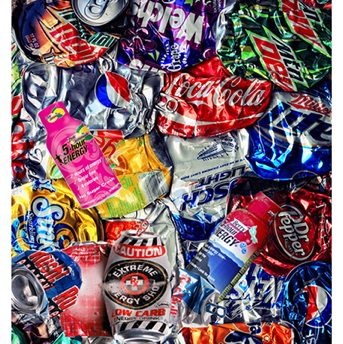Like many cyclists, I enjoy those brief winter thaws when the snow melts, road shoulders reappear and we can squeeze in a few rides. It’s fun to be able to pedal again, and it’s also a revealing time.
As the snow melts, it uncovers items of interest to naturalists — rodent tunnels and frozen roadkill — but I’m much more interested in the caffeine. Just as receding glaciers uncover secrets of past cultures, the melting snow reveals a cross-section of modern caffeine culture.
Riding along Route 1 in coastal Maine recently, I saw lots of coffee cups, from Dunkin’ Donuts, Green Mountain Coffee, Hannaford and McDonald’s. It’s no surprise to find coffee cups along the road — most Americans take caffeine daily, and most of that caffeine comes from coffee. Coffee is practically synonymous with caffeine, but the cups were the least conspicuous caffeine delivery mechanisms beside the road.
More colorful were the bright blue and yellow cans of Brisk tea and bottles of Nestea tossed here and there. Although we usually think of tea as something that comes from a bag soaked in hot water, more than three-quarters of tea in America is consumed iced. Increasingly, much of that flows through the fast-growing ready-to-drink sector.
A pink vial, flattened into the roadside gravel, nearly escaped my gaze. It was a shot of 5-hour Energy, branded for breast cancer awareness. I also spotted the company’s standard shots, with their red and black label, and one of the black-label extra-strength shots. Nonexistent a decade ago, but now cluttering convenience store counters nationwide, the little plastic caffeine containers are relative newcomers to the road shoulders.
Energy drink containers also abounded, some exposed on newly thawed pavement, others still half-frozen into the roadside snow. There was Red Bull, of course, but also Rockstar, Full Throttle, Amp, Nos and Monster, Monster and more Monster. This is another new trend. I saw few energy drinks along the road five years ago. Now they are everywhere.
But the vast majority of the caffeinated litter was not coffee, tea or energy drinks. It was soft drinks, especially various permutations of Coke and Pepsi — sugared and diet, in cans and in bottles — all packing caffeine.
In 1975, soft drinks overtook coffee as America’s favorite beverage and never looked back. Although we drink far more soft drinks than coffee, and the vast majority of sodas are caffeinated, we still get most of our caffeine from coffee, which has higher concentrations of the drug. Future archaeologists will be able to test this by comparing the residue in the coffee cups and the soda cans.
It may seem a reach to imagine that anyone will be interested, but that’s exactly how we’ve come to learn about historic caffeine use. A team of archaeologists found caffeine on vessels 3,500 years old, in Chiapas, Mexico, remnants of ancient chocolate drinks. To date, it’s the earliest documented use of caffeine by people.
And in 2012, researchers found traces of caffeine on ceremonial vessels at Cahokia, a once-bustling mound city along the Mississippi, where Native Americans used the leaves of yaupon holly to brew a tea more than 800 years ago.
These days, we are bequeathing so much caffeine-stained material to archaeologists that they might wonder, 3,000 years hence, if we organized our days around doses of the stimulating alkaloid. Consider K-Cups, the coffee pods popularized by Green Mountain Coffee Roasters. In 2013 alone, Green Mountain sold more than 8 billion of the pods. Lined up, they would encircle the Earth more than 10 times at the equator.
But that’s nothing compared to Coke. Coca-Cola claims that it has sold so much of the caffeinated soft drink that if you put it into 8-ounce bottles and stacked them, they would not only reach to the moon and back, they would do so more than 2,000 times.
So I was not surprised to see a Coke delivery truck coming up the road as I pedaled along, a tractor-trailer emblazoned with the red-and-white logo familiar worldwide. But I was surprised to see yet another huge Coke truck pass not 10 minutes later, ferrying still more bottles to rural Maine stores. This one was emblazoned with Coke Zero logos. Like Diet Coke, Coke Zero has no calories. It’s nothing but carbonated water blended with artificial flavors and sweeteners … and caffeine.
As the truck passed with a gust of wind, my bike shuddered slightly in its wake. Then I resumed my scan of the winter grit beside Route 1, reading the story of caffeine in modern America.
Murray Carpenter of Belfast is a freelance writer and author of the 2014 book “Caffeinated: How Our Daily Habit Helps, Hurts, and Hooks Us.”
 Copy the Story Link
Copy the Story Link
Send questions/comments to the editors.



Success. Please wait for the page to reload. If the page does not reload within 5 seconds, please refresh the page.
Enter your email and password to access comments.
Hi, to comment on stories you must . This profile is in addition to your subscription and website login.
Already have a commenting profile? .
Invalid username/password.
Please check your email to confirm and complete your registration.
Only subscribers are eligible to post comments. Please subscribe or login first for digital access. Here’s why.
Use the form below to reset your password. When you've submitted your account email, we will send an email with a reset code.